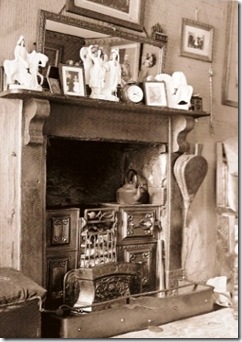Photographic collections are always fascinating. There is no need to know anything about lenses or details of exposure, or the camera used, or the film on which the image was taken, they can just be pictures for their own sake.
Looking through Edwin Smith’s Evocations of Place, a very generous present received more than a decade ago, there is an evocation not just of place, but of characters long dead.
Mrs Holman, owner of the cottage in which Edwin Smith took a photograph of the fireplace in 1936 is a lady whose place tells much about its owner.
Mrs Holman lived in the little Somerset town of Crewkerne, a town on the A30, the old trunk road from London to Land’s End. It would have been a bustling and prosperous place, for there was enough work for the foundry that made the fine range that sits in her hearth.
Mrs Holman is a lady with a sense of the value of things rather than the price of things. A pair of horsemen sit either side of her mantlepiece, the rider to the right is headless, but what matters is that such heirlooms are preserved and passed on. It would have been alien to people of Mrs Holman’s generation to have gone to someone and asked, “How much is it worth?” Value was something far greater than price.
Mrs Holman’s family are central to her life. Sitting at her fireside each evening, she would have looked at the framed photographs lined up amongst the china, who was living and who was dead? We don’t know. In the 1930s, before the development of antibiotics, many lives were very short.
Mrs Holman is traditional in her politics. This is safe Tory territory and her mirror reflects a picture of the king. He was probably the old king by the time the photograph was taken, the young Edward VIII having acceded, for King George died in January and there is no fire in the hearth to suggest that the picture was taken so early in the year.
Mrs Holman is fastidious about timekeeping, the clock that sits on the mantlepiece is a big brass alarm clock. it shows just after quarter past two. Mr Smith probably arrived at two o’clock to take his photographs and Mrs Holman would have been waiting for the knock at the door.
There is so much evoked in a single photograph, a photograph which the Royal Institute of British Architects prosaically catalogues online under “Fireplaces.” Clearly, they had missed the details of Mrs Holman.



In Scotland it was common for homes to have a Parlour often known as The Front Parlour, conveniently near the front door, off the entrance hall, where persons suitable for The Parlour entered and exited.
This was a fully equipped room which was only used for serious occasions, such as a visit by The Minister, or funeral teas. Children were forbidden.
This reminds me of these.
The working kitchen where all normal life was lived was a big room at the back of the house, znd no stranger would be allowed in there. Probably the back door gave access directly and non special people always used this.
I wonder if the same arrangement held in English regions?
The fireplace in the photograph looks unused. No smoke stain above it. It does not look like “proper” enclosed range, but has an open fire. Maybe it pre-dates the enclosed range.
But they all required regular application of Zebo.
Even when I was a child, only 60 years ago in N. London, the front room was never used except for special occasions.
My grandparents’ farmhouse had two front rooms, one was as you describe, kept for very special occasions.
I remember visiting houses during my time in parish ministry where I would have to be seated in the “good room.”
I am a descendant of Mrs Holman. It is so lovely to see family recorded in this way – there are several pictures of the family in the Edwin Smith Collection.
Thank you.
I think sitting either side of that hearth with Mrs Holman, drinking tea from china cups, would have been a delightful experience.